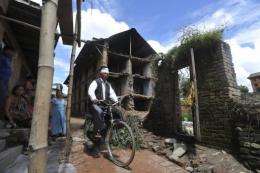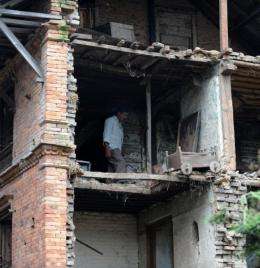Nepal capital tops quake risk list

With rescue work still under way in Nepal after the deadly earthquake in the Himalayas, scientists have warned that the capital Kathmandu is a high-risk city unprepared for the next "Big One".
Experts say Kathmandu is one of the most vulnerable cities in the world with an overdue earthquake predicted to kill tens of thousands of people and leave survivors cut off from international aid.
British geologist Dave Petley described the latest tremor, which killed eight people in Nepal, as a "wake-up call" for the overcrowded capital, home to two million people and connected to the outside world by just three roads and one airport runway.
"The main area of concern is in central and west Nepal, where there has not been a large earthquake for a long period," Petley told AFP after Sunday's 6.9-magnitude quake damaged hundreds of homes in the east of the country.
"This is an earthquake-prone area, so this suggests that there is a large amount of energy stored," he said.
Nepal is a highly seismic region, lying above the collision of the Indian and Eurasian plates that created the Himalayas, and major earthquakes have hit the Kathmandu Valley every 75 years on average over recent centuries.
One quake destroyed a quarter of homes in Kathmandu 77 years ago, and geologists believe the area is at immediate risk of an 8.0-magnitude tremor -- ten times the size of last year's Haiti quake which killed more than 225,000 people.
Downtown Kathmandu is a maze of narrow, winding roads where rickshaws and cars jostle with cows to squeeze past dilapidated clay, brick and timber houses.
"The building stock is not seismically strengthened, suggesting that in a big earthquake there will be large numbers of building collapses," said Petley, of the Institute of Hazard, Risk and Resilience at Britain's Durham University.

GeoHazards International, a US-based research group, has measured the likely death toll from a quake of 6.0 magnitude or higher hitting cities in Asia and the Americas.
Kathmandu topped the list of 21 cities with 69,000 potential deaths, ahead of Istanbul and New Delhi.
The Kathmandu Valley has experienced rapid, uncontrolled urbanisation in the past few years and the lack of infrastructure and deep-rooted poverty leave it desperately underprepared for an earthquake, experts say.
Building codes are rarely enforced, few emergency drills are carried out, and the fact that Kathmandu lies on the site of a prehistoric lake filled with soft sediment also exacerbates the risk.
The one single-runway airport and all three access roads would likely be destroyed in a major quake, meaning the city could be stranded.
GeoHazards president Brian Tucker told AFP that researchers had compared the probability of a child in Kathmandu dying because an earthquake destroyed a school with the probability of the same situation in Tokyo.
"The child in Kathmandu was 400 times more likely to die. This inequity is intolerable," he said.
The National Society for Earthquake Technology (NSET), established after a 6.5-magnitude tremor killed more than 700 people in eastern Nepal in 1988, has launched a programme to make school buildings more quake-resistant.
According to NSET, if a 7.0 magnitude quake hit Kathmandu, 200,000 people would die, another 200,000 would be severely injured, 1.5 million would be made homeless and 60 percent of homes would be destroyed.
Underlining the dangers, three of the eight deaths in Nepal from Sunday's quake happened when a wall of the British Embassy compound in Kathmandu collapsed, killing a father, his eight-year-old daughter and another man.
The quake, on the border between India's Sikkim state and Nepal, killed at least 83 people across the region with emergency teams battling to get to remote communities near the epicentre.
"We have to take this risk very seriously and we have to assume the worst," UN humanitarian coordinator in Nepal Robert Piper told Tuesday's Kathmandu Post.
"It's the right thing to do, which is to assume this could happen again tomorrow or in 10 years -- we really don't know."
(c) 2011 AFP


















